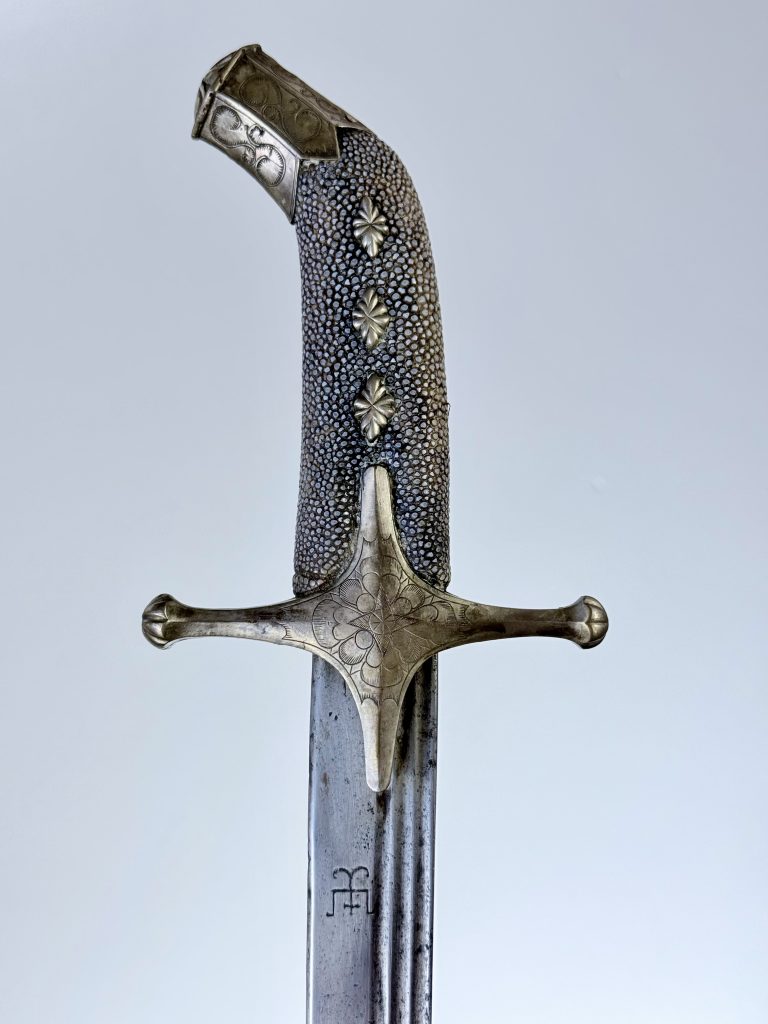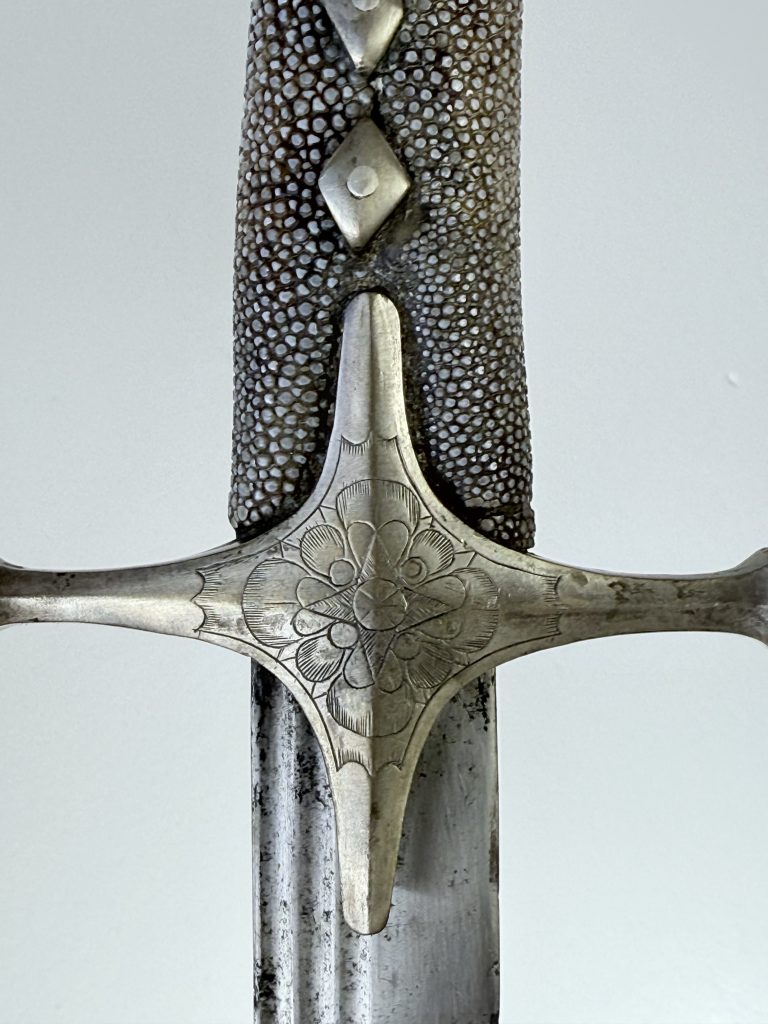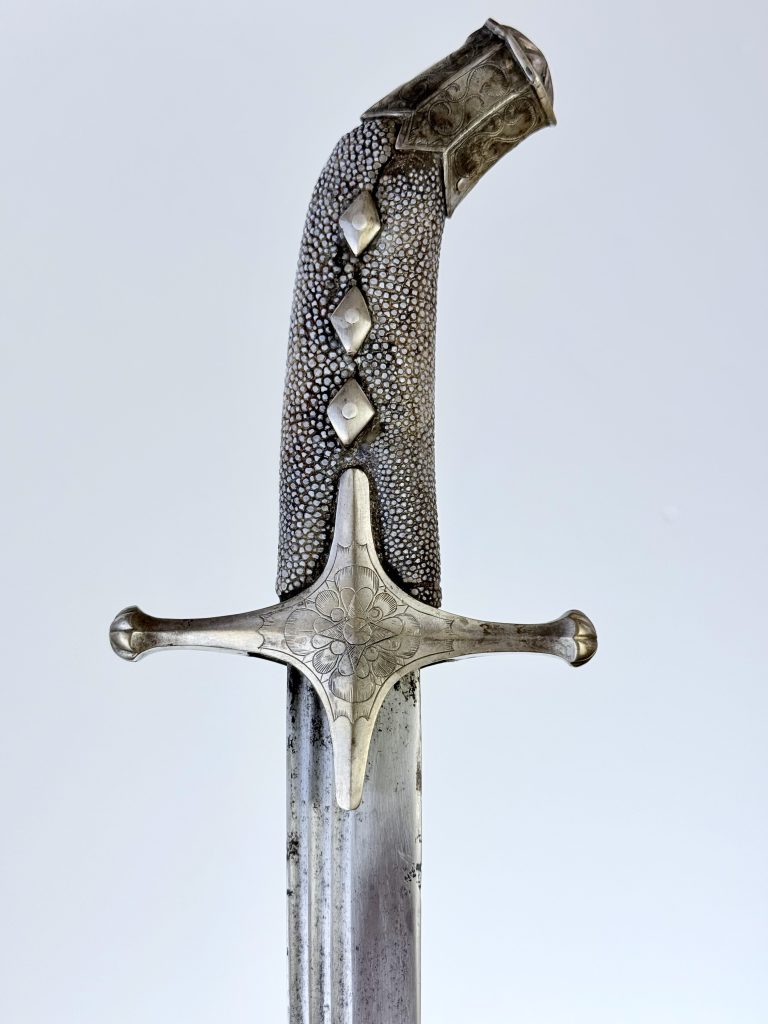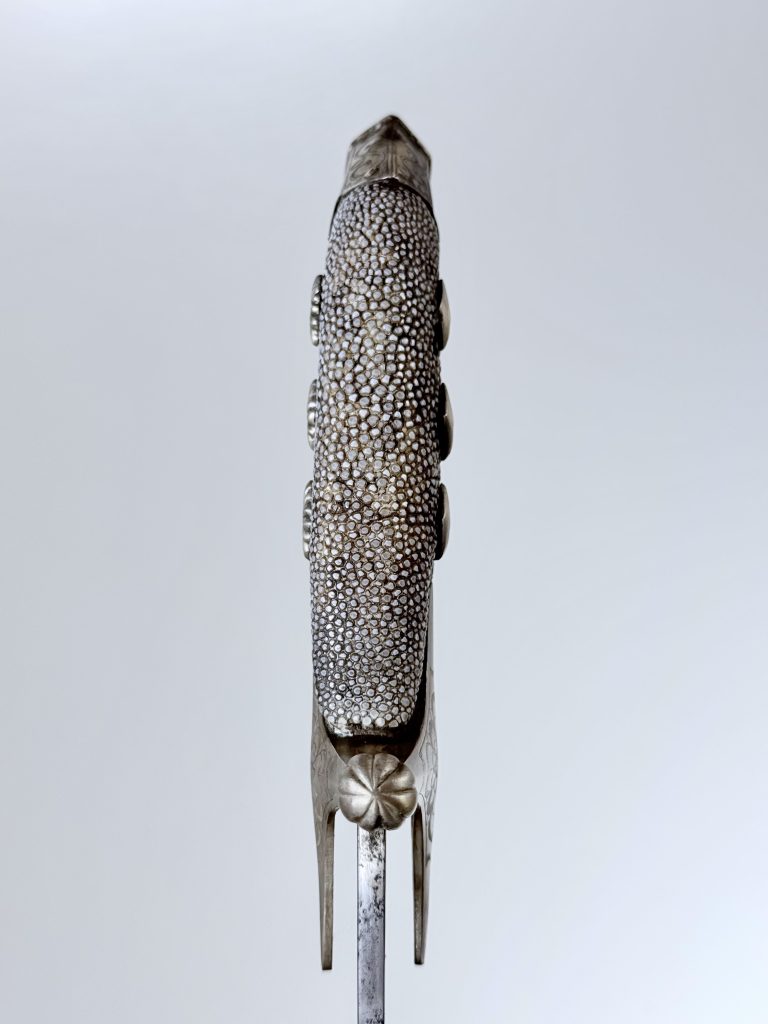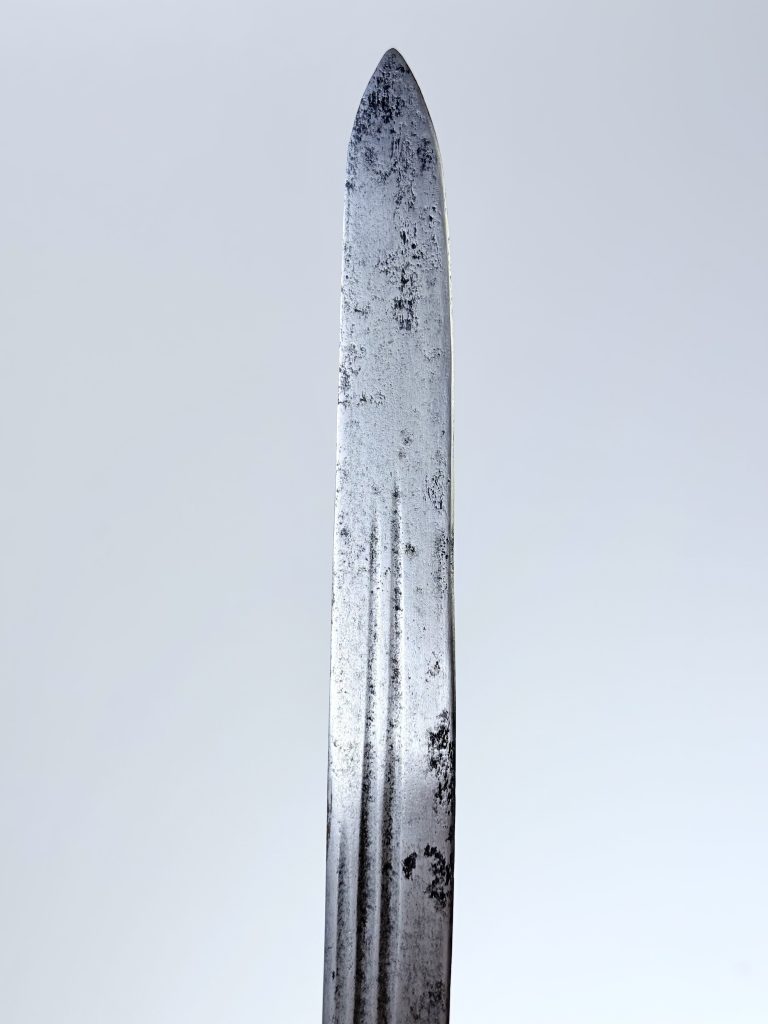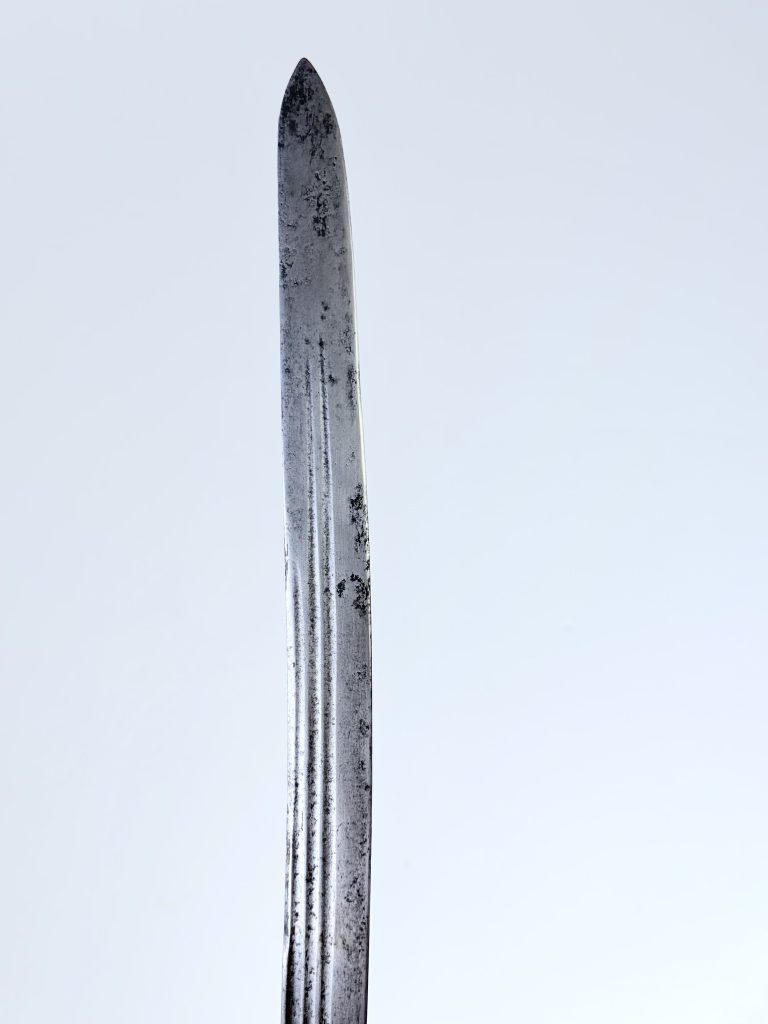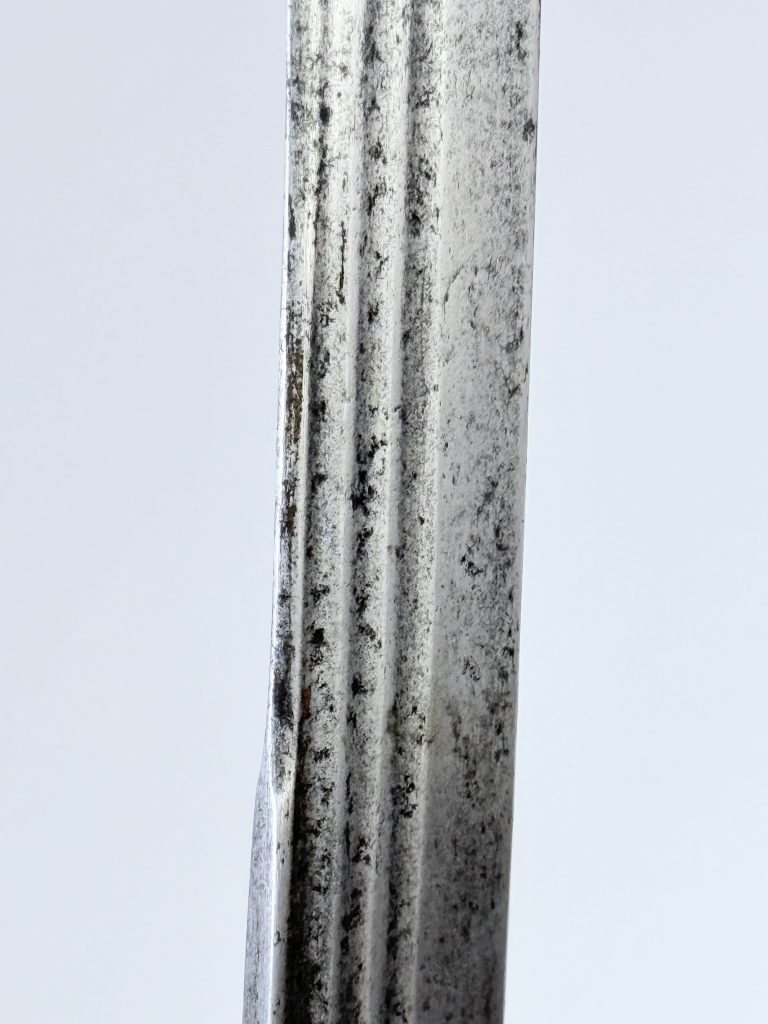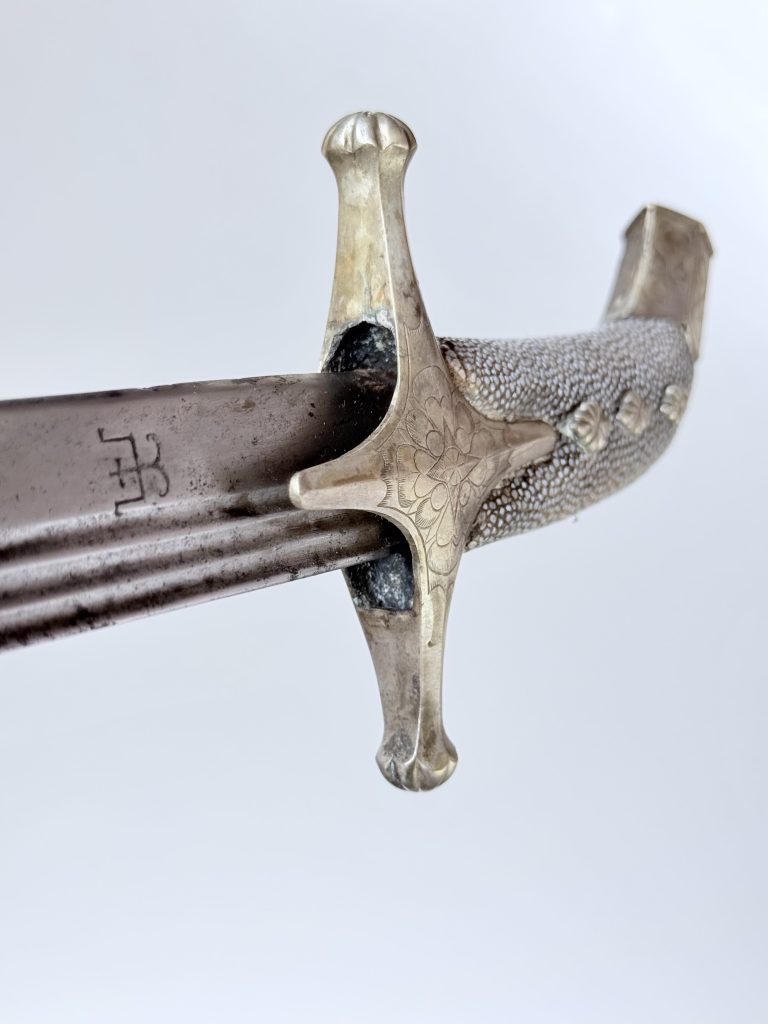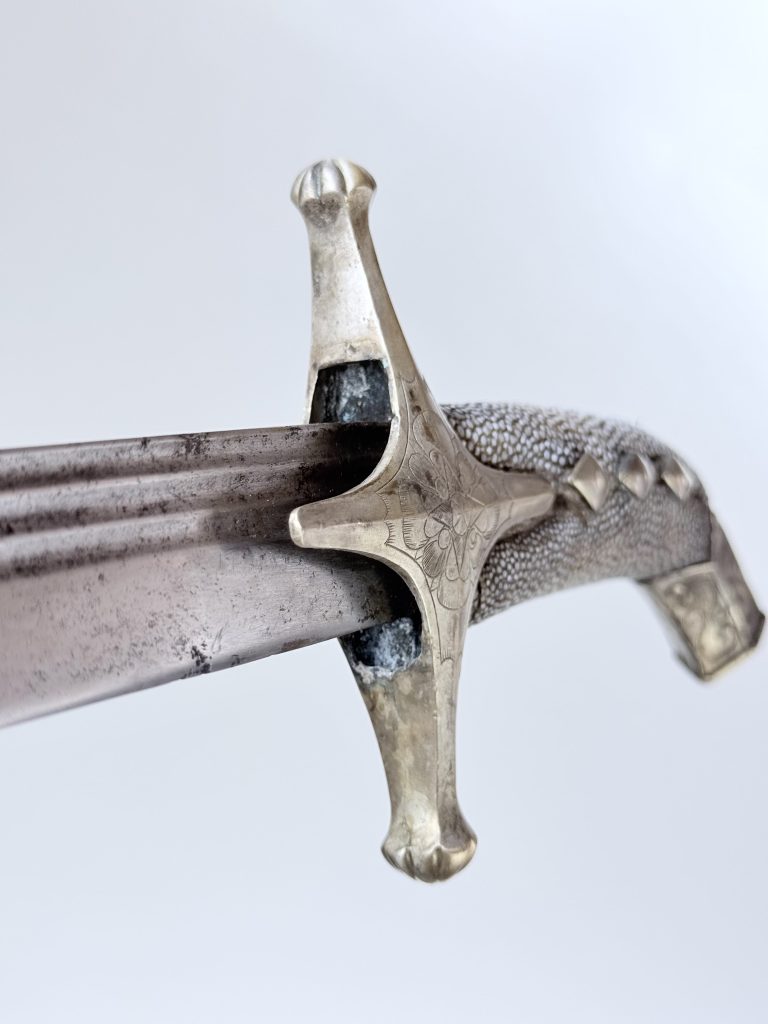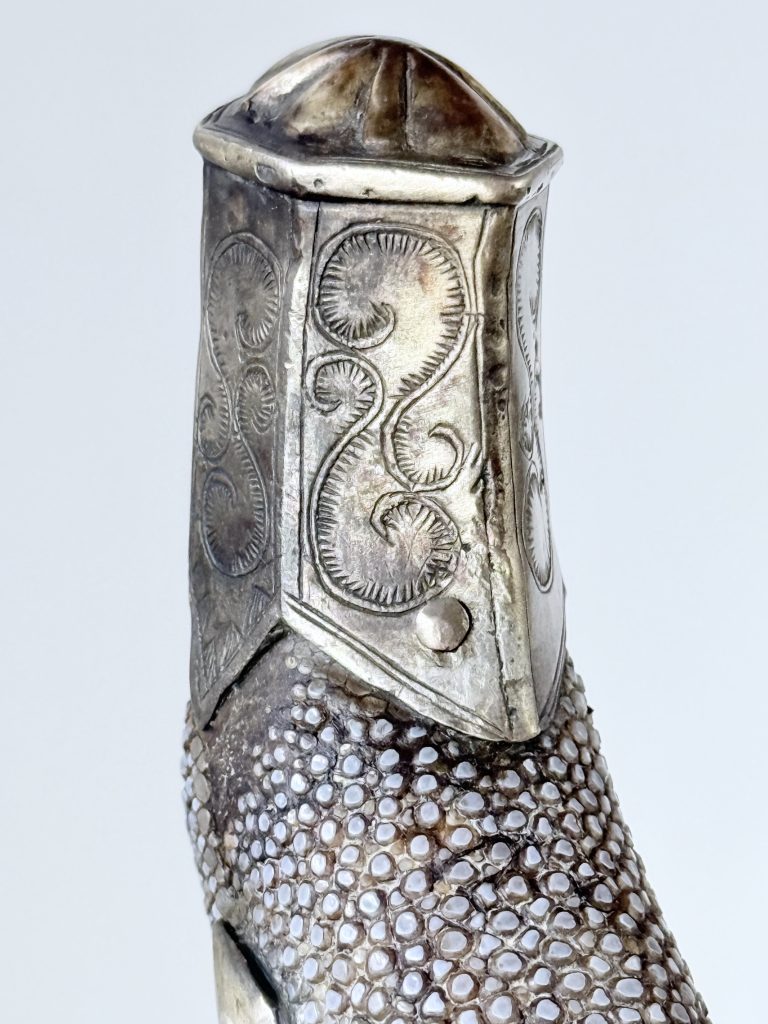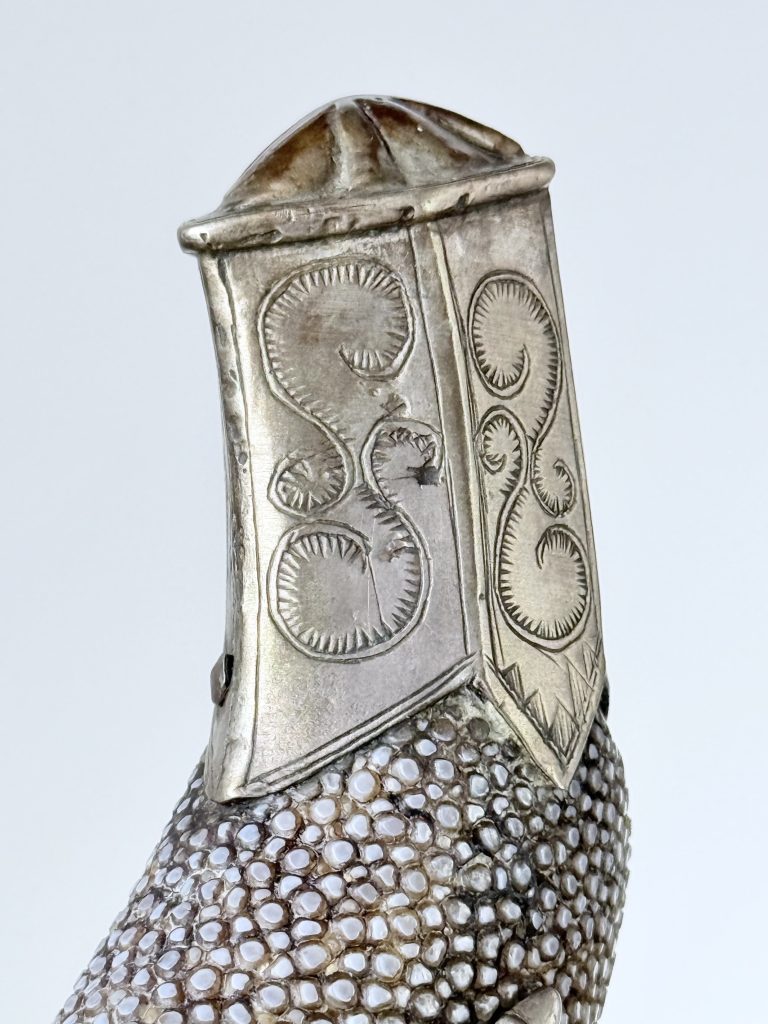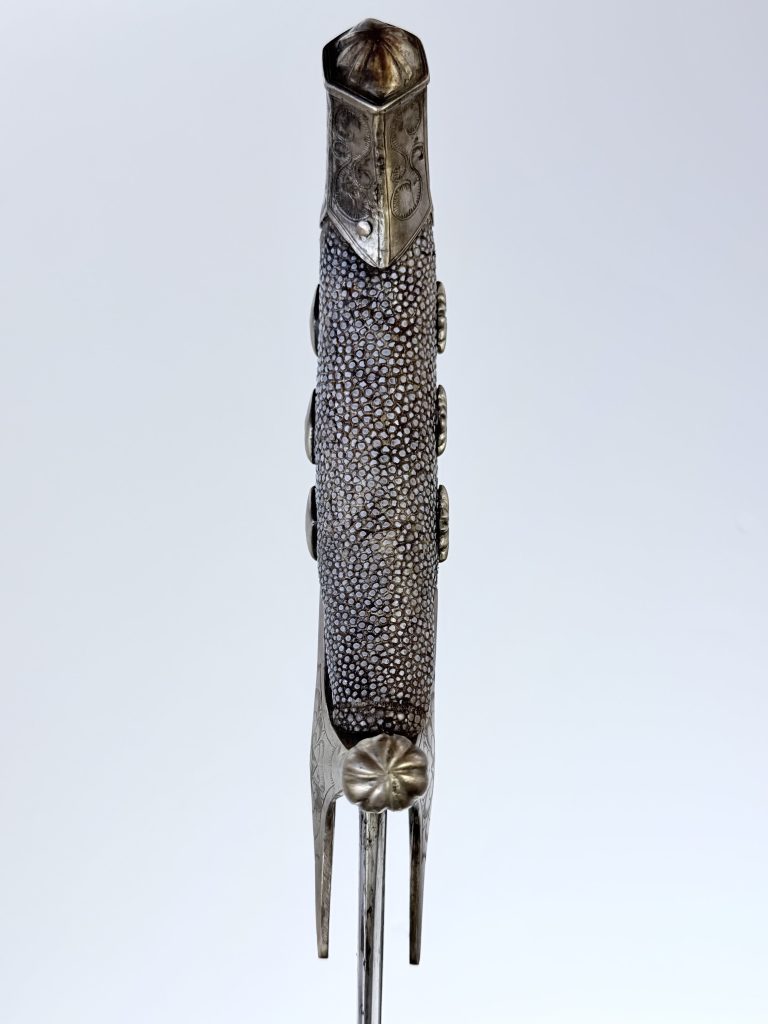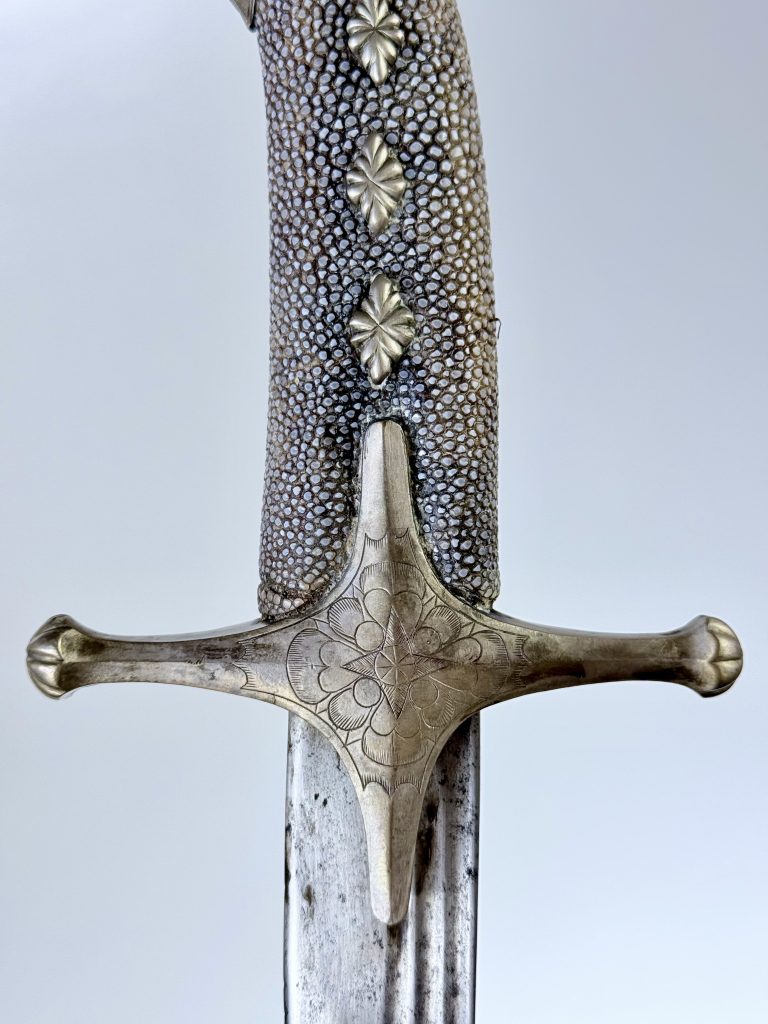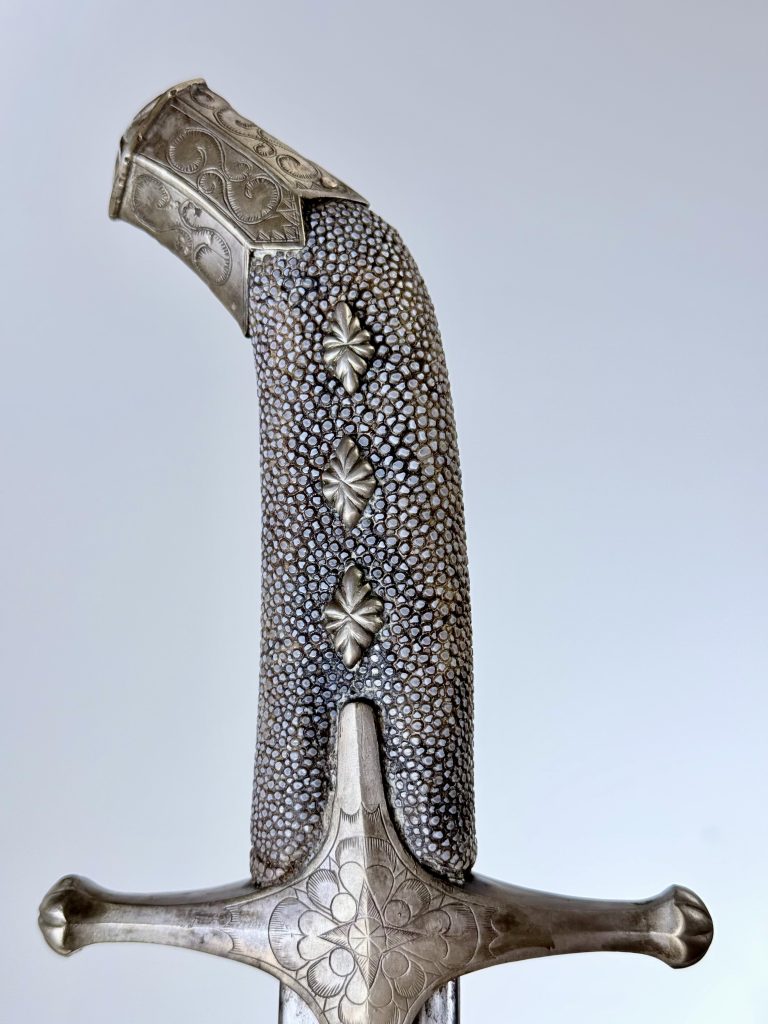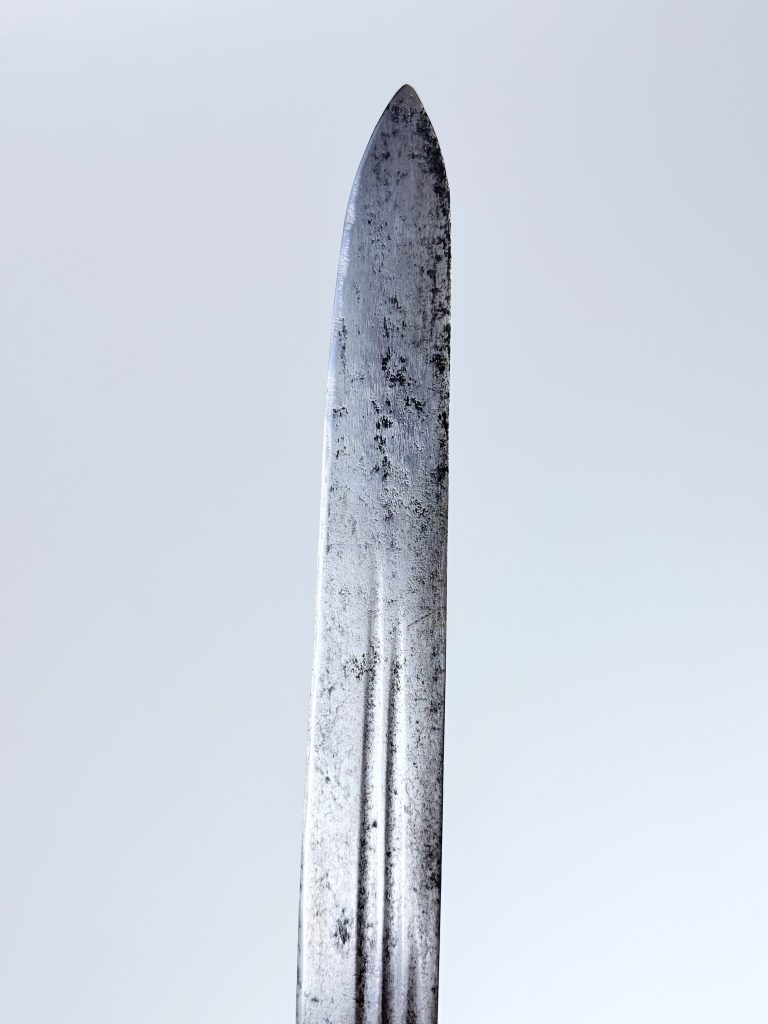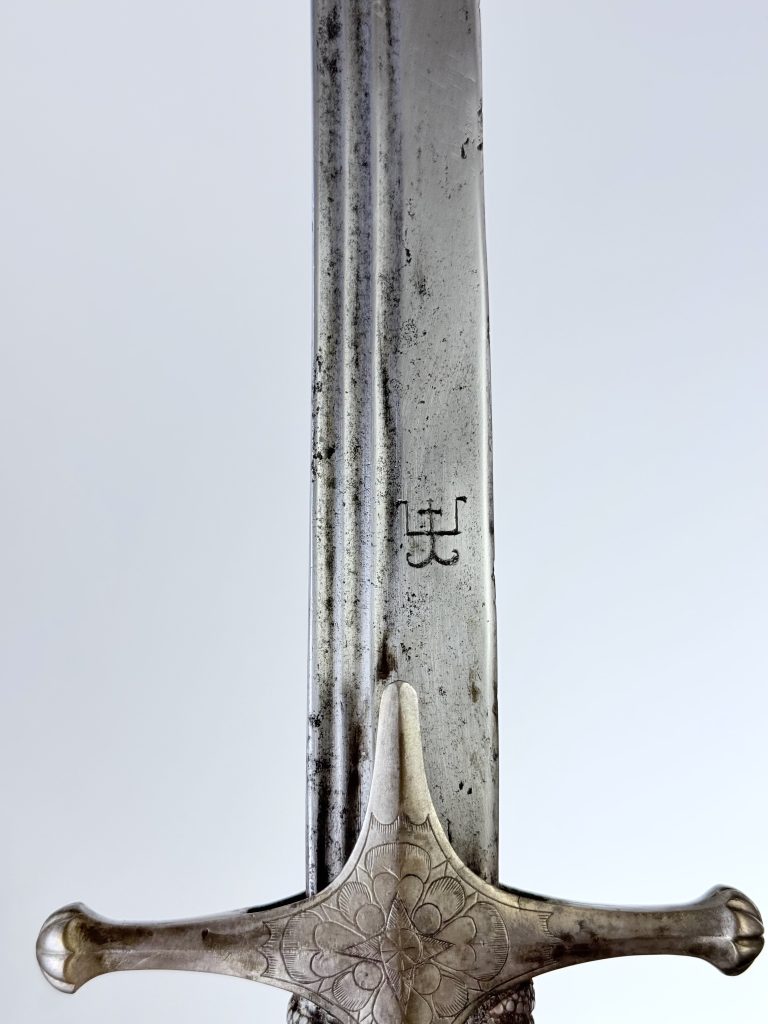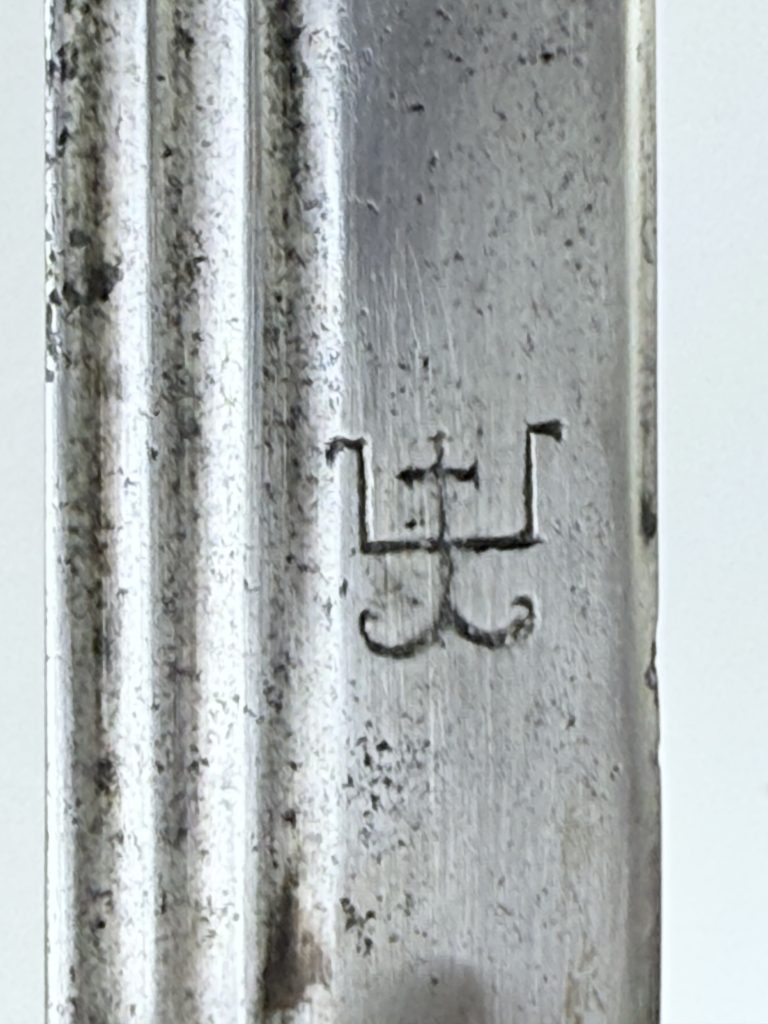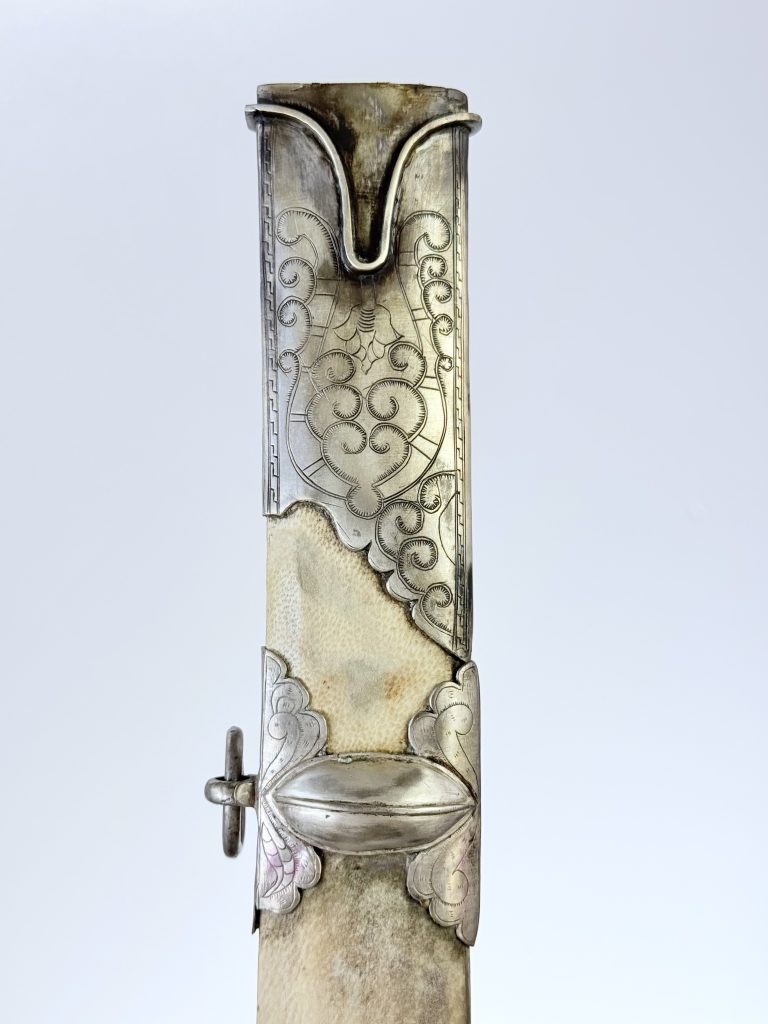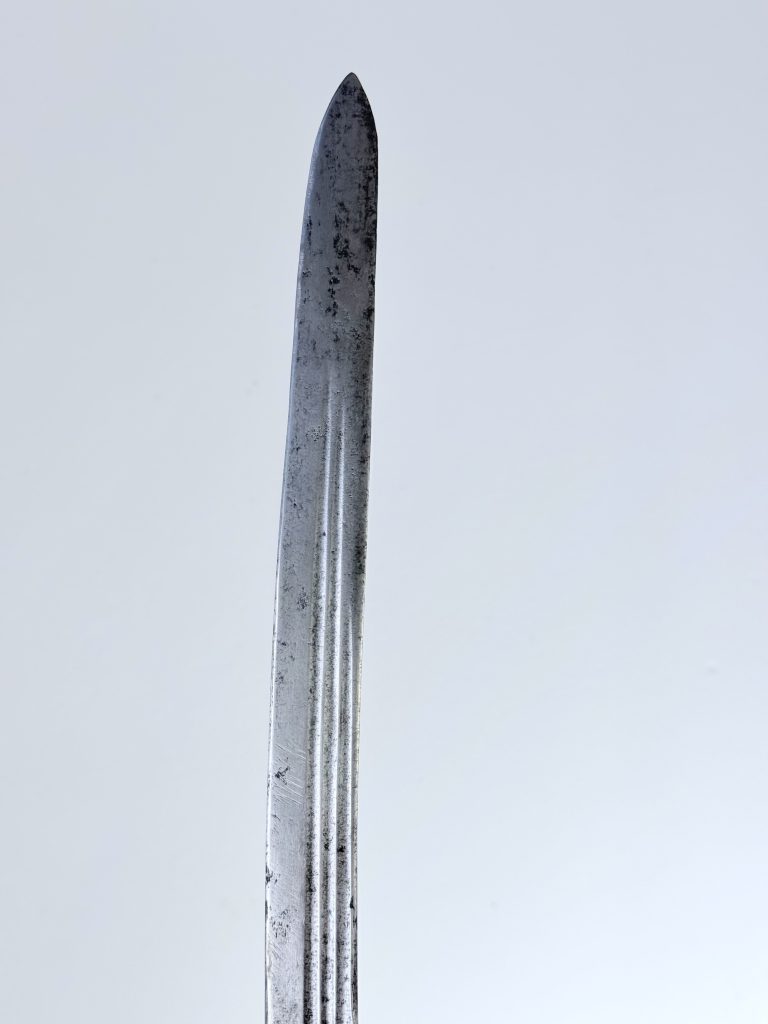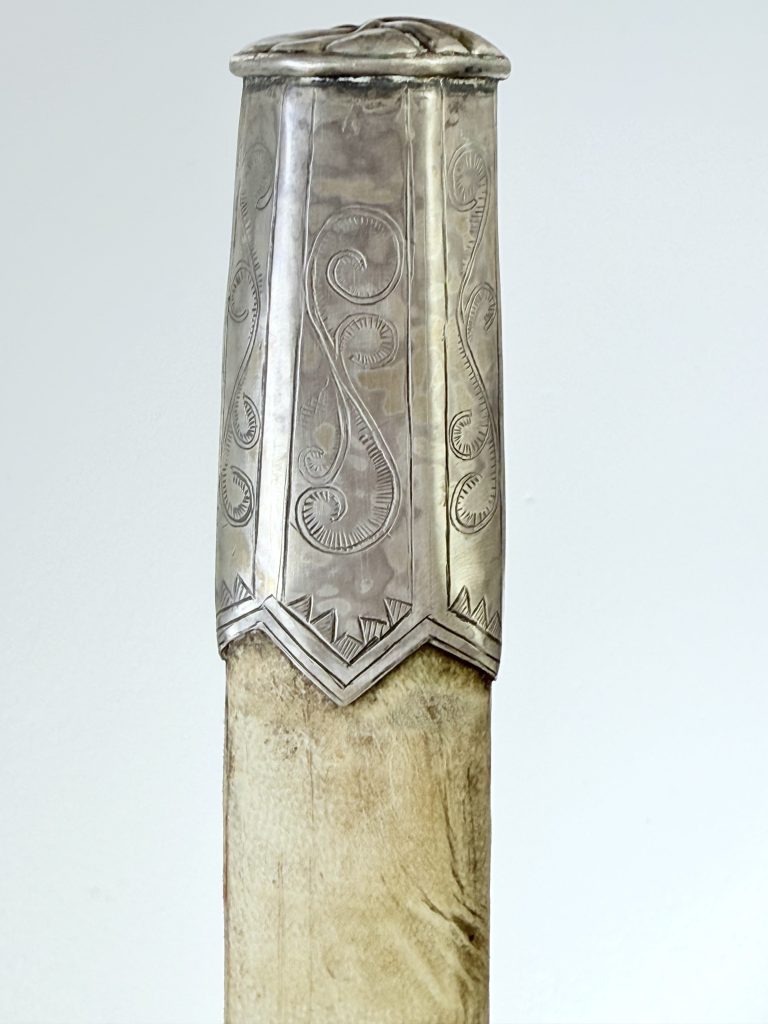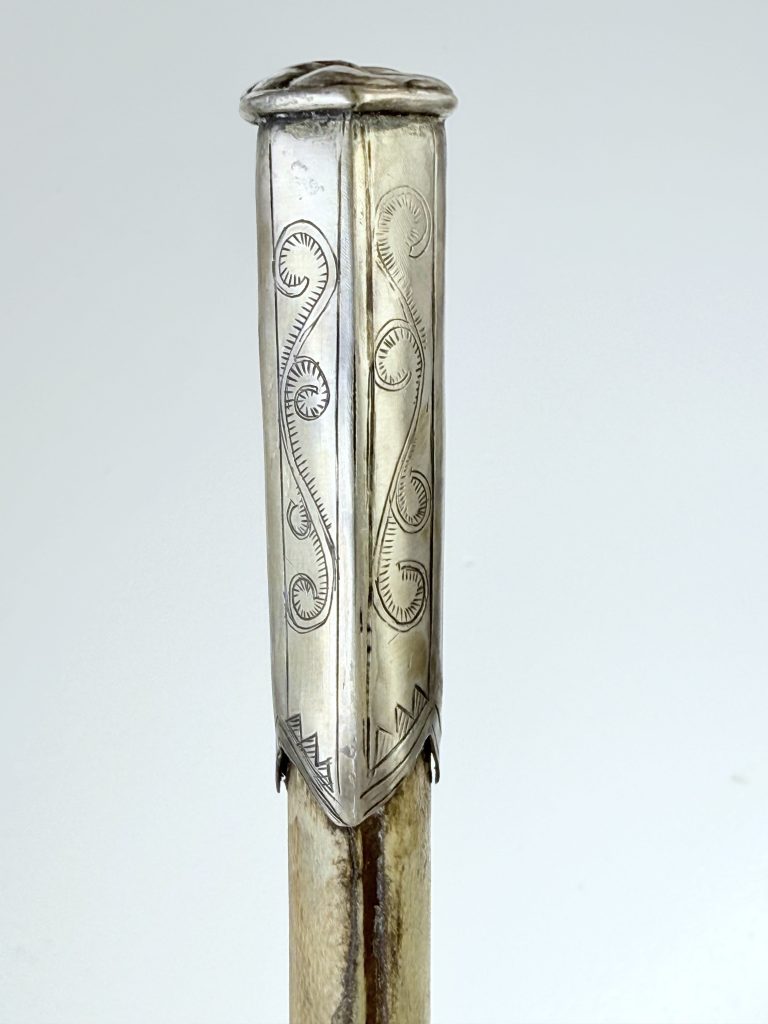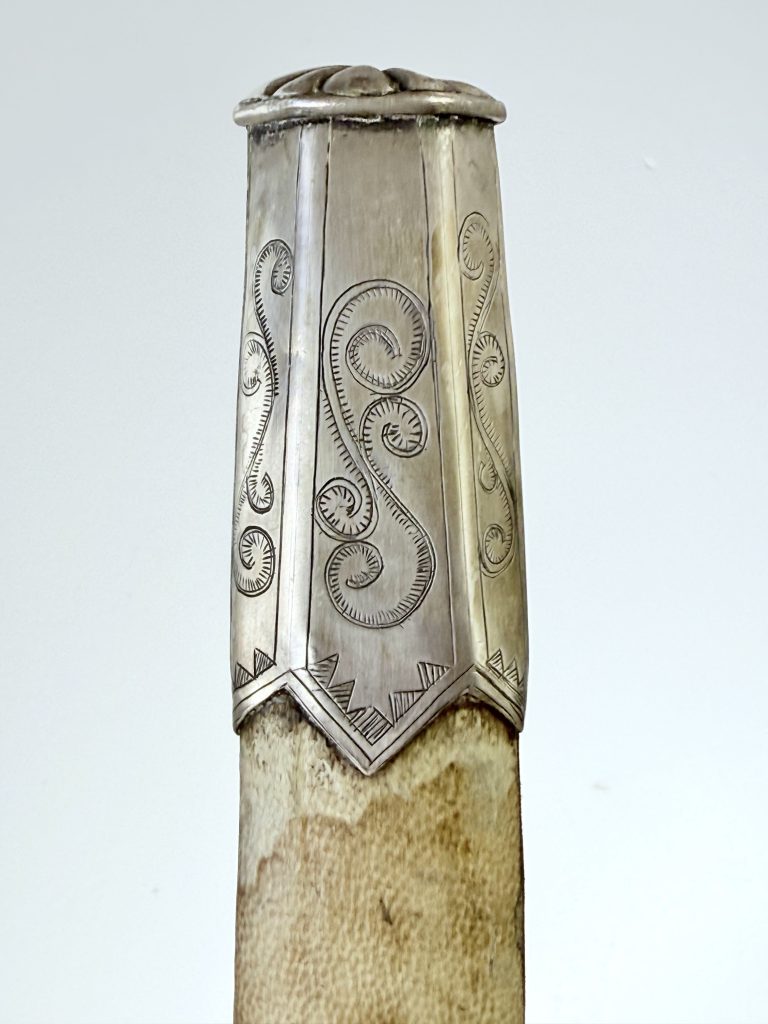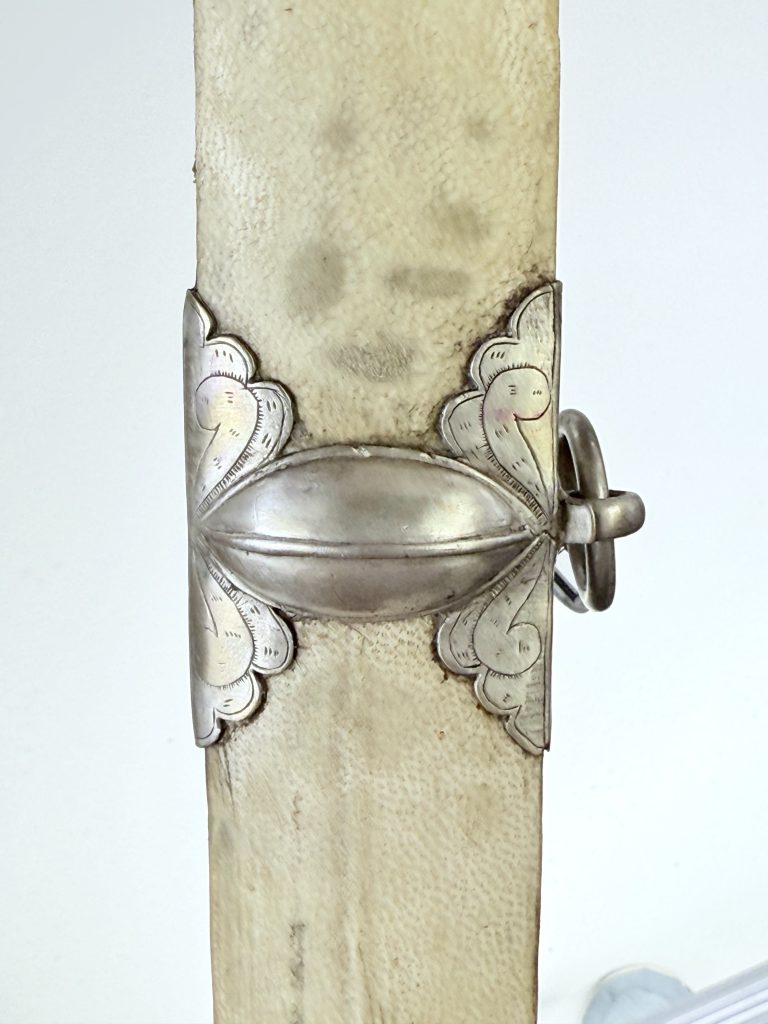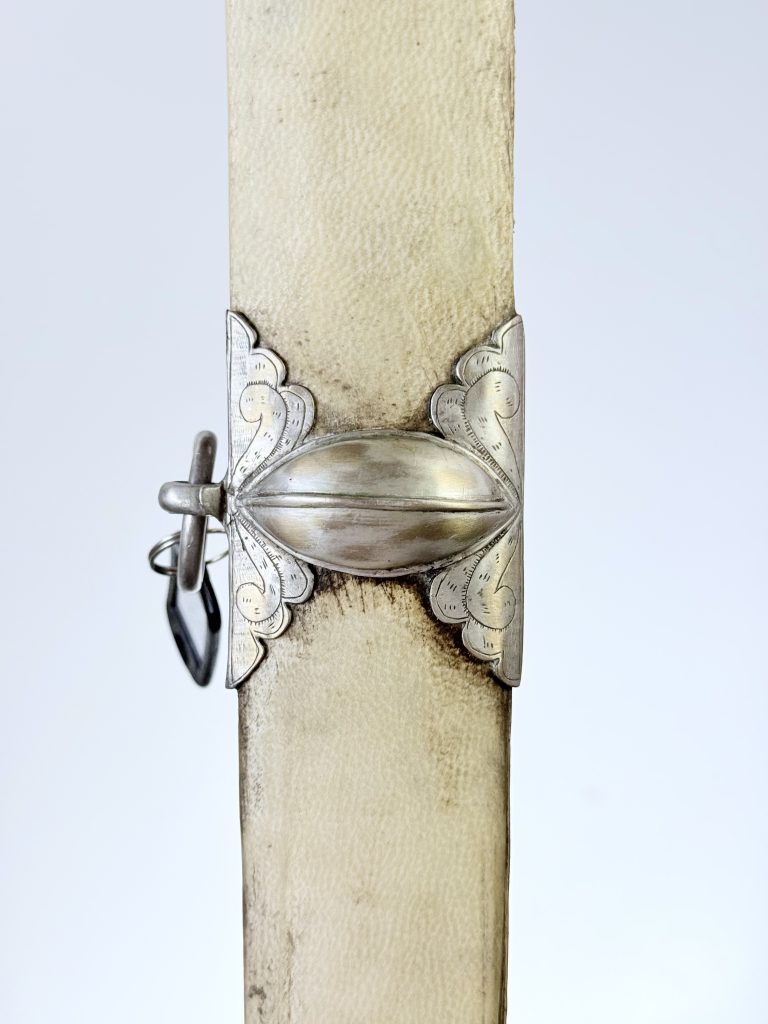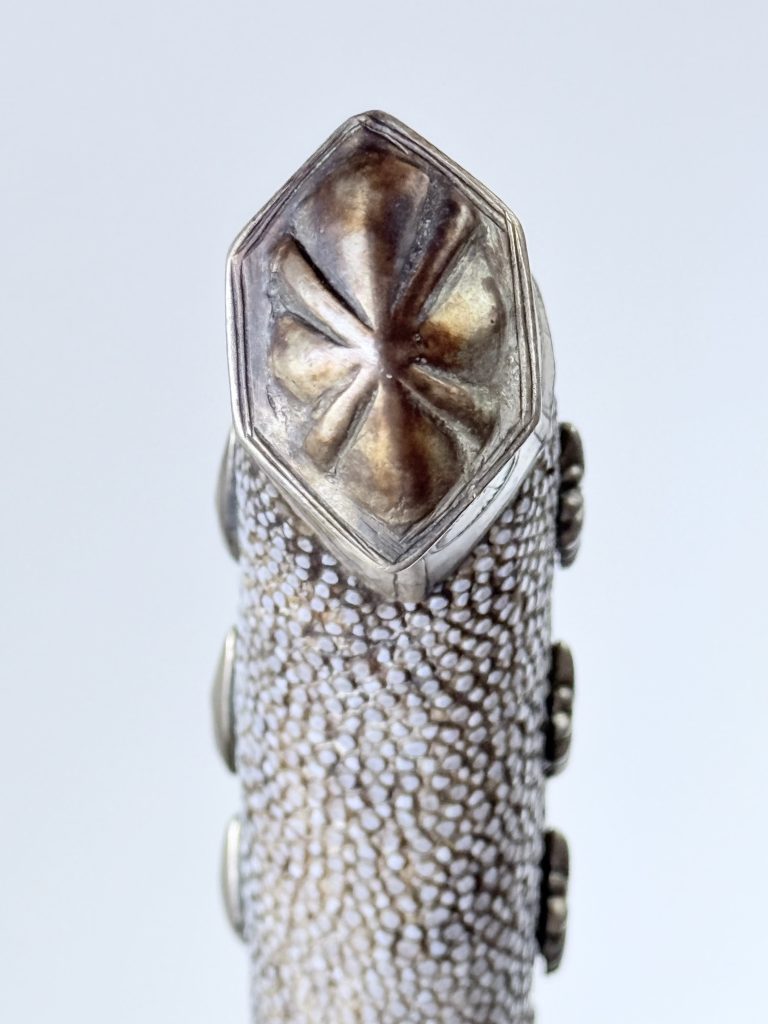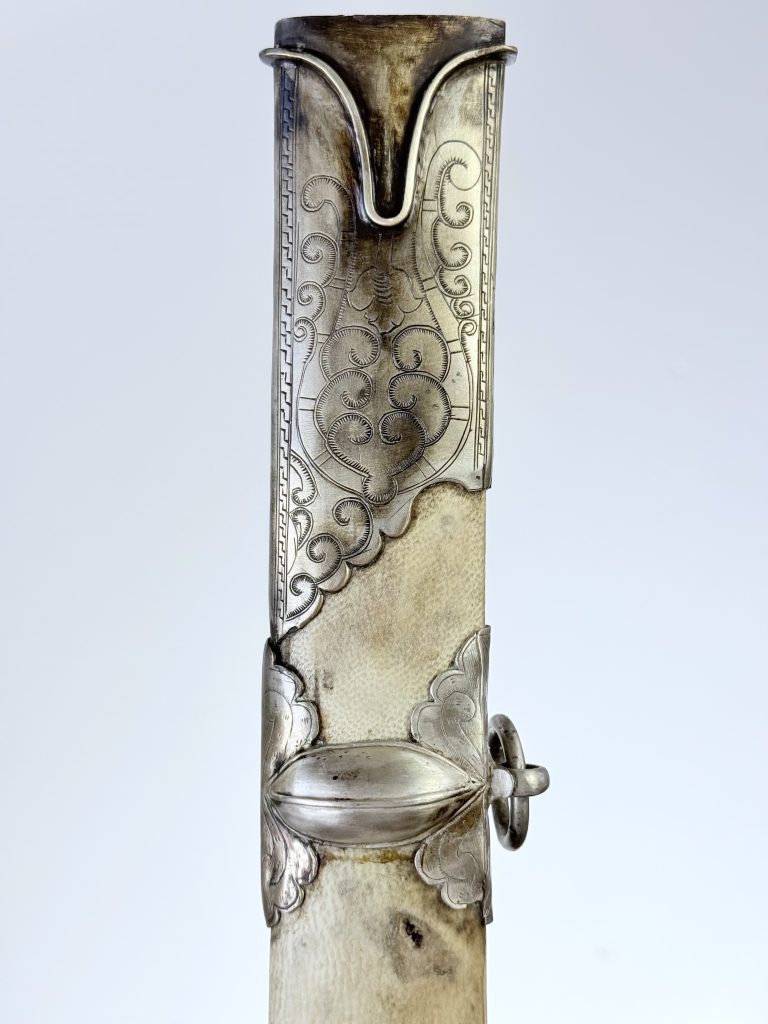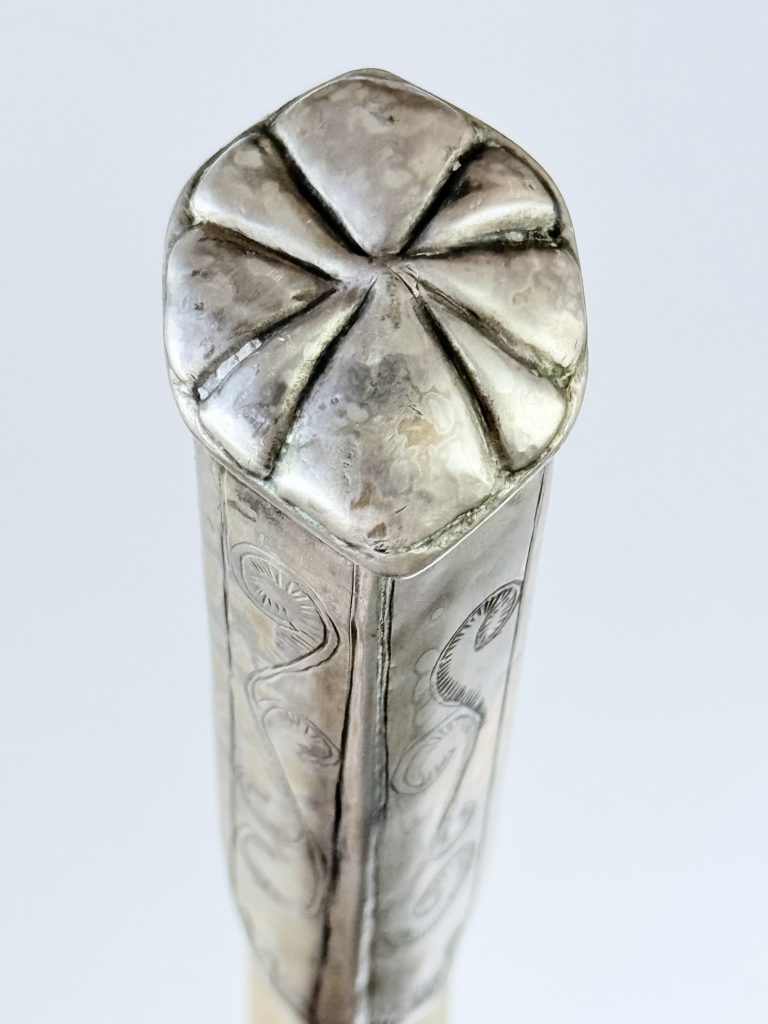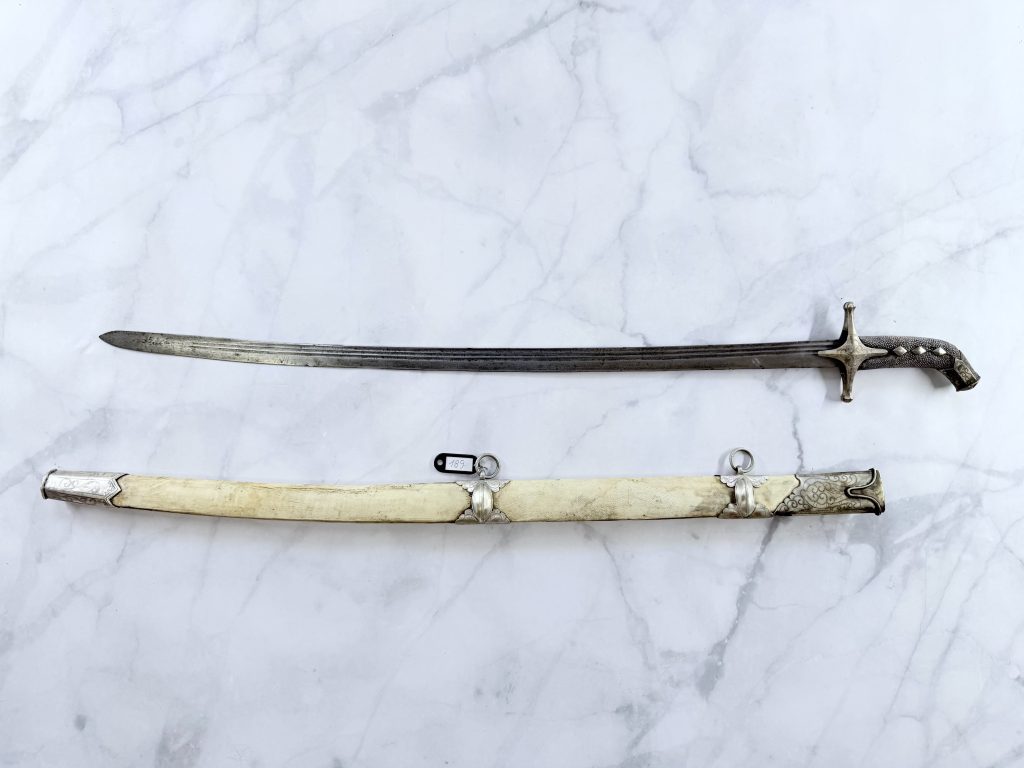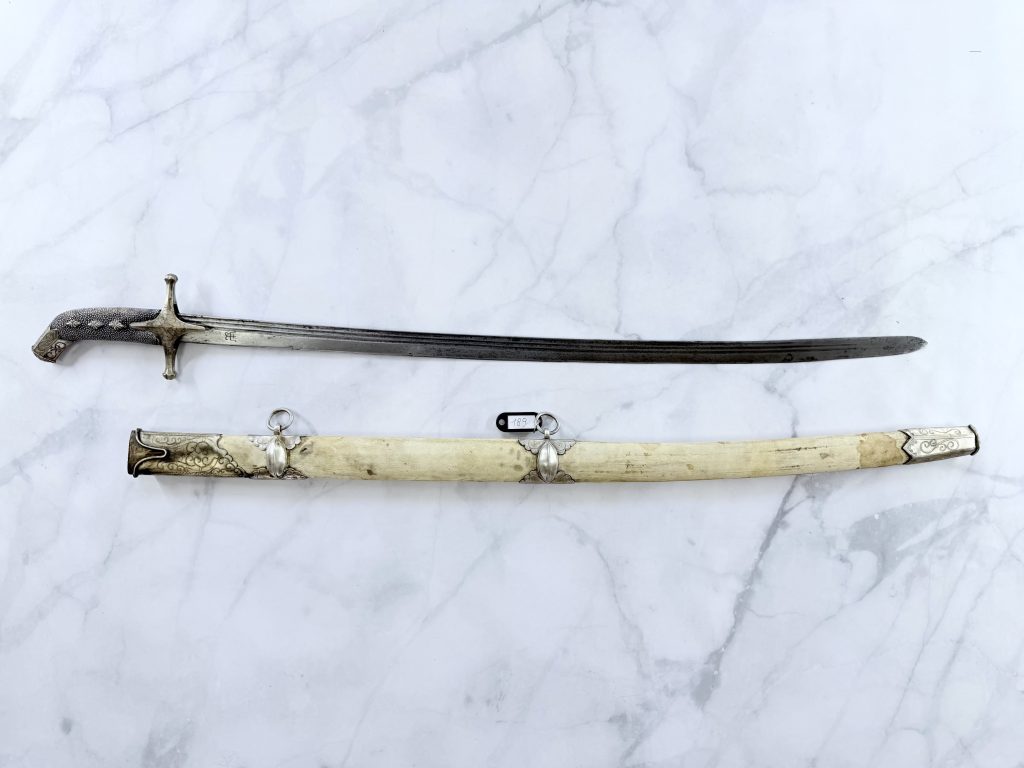Bardzo rzadka szabla Ordynka, Polska – Litwa, 1675 – 1725, z herbem Glińskich.
Bardzo rzadka szabla Ordynka, Polska – Litwa, 1675 – 1725, z herbem Glińskich.
A very rare Ordynka saber, Poland – Lithuania, 17th-18th century, with tamga (coat of arms) of Glinski family.
Concerning:
Investigation raport of an Ordynka Saber. Expected Origin / Period: Poland – Lithuania, 1675 – 1725
Description:
An Ordynka saber with scabbard. Comes with full Belgian laboratory report, confirming authenticity. The cross-guard with knobbed-end quillons is decorated with floral engravings on both sides. The upper stand pommel with embossed relief on top is decorated with geometric engravings on the facets. The grip is covered with ray skin, fixed with three rivets on the sides. The blade has a double-edged tip. Embossed rosettes on one side of the grip. It is slightly curved and three fullers are running along the upper side. The fittings of the scabbard are decorated with floral and geometric engravings according to the guard and pommel. Two silver suspension rings and a fitting are still present. A natural shagreen covers the wooden scabbard.
This type of saber was used in Poland – Lithuania during the reign of King Jan III Sobieski and ended in the first quarter of the 18th century, can be dated circa 1675 – 1725. Near the guard, tamga of the Gliniski family is engraved on the blade; it’s a Tatar-origin noble family from the Grand Duchy of Lithuania.
Dane techniczne szabli:
Weight
total – 1130.3 g
saber – 651.0 g
scabbard – 479.3 g
Total length
104.3 cm
Blade
length – 81.8 cm
width at the guard – 30.2 mm
thickness at the guard (max–min) – 5.6 – 1.1 mm
Scabbard
length – 90.0 cm
width (max – min) – 51.0 – 31.6 mm
thickness (max – min) – 21.6 – 17.4 mm
Guard
cross – 110 × 75 mm
thickness – 25.3 mm
Grip
length – 18.5 cm
thickness (max – min) – 30.3 – 24.6 mm
Pommel
length – 4.3 cm
thickness × width (trapezoid) – 19 × 27–31 mm
Rivets
length – 16 – 15 – 15 mm
width – 10 – 9 – 8 mm
Counter rivets
length – 16 – 17 – 16 mm
width – 10 – 9 – 10 mm
Observations
Engraved tamga on the blade
Reference:
Coat of arms of Glinskai (from the book by A. Kojalavičius-Vijūkas: Coat of arms of the nobility of the Grand Duchy of Lithuania, called Nomenklatorius, published in 1905 in Cracow: Warsaw National Library)
Total length: 96.1 cm
Silver guard, with quillons in mushroom-shape ends, decorated with vertical grooves. Long langets. Center of the guard, from both sides, is decorated with florals motifs – stylized flower blossom in a frame. Faceted silver pommel is decorated with geometric motifs, with embossed relief on the top. Wooden grip is covered with ray skin, fixed to the blade tang with three rivets, decorated with rhombus shape rosettes – decorated in averse and equal in reverse of the handle. Blade European, dating to 17th–18th century, single edged, slightly curved, double edged near the tip. Three narrow fullers going along the upper side of the blade. On averse, near the guard, tamga of Glinski family is engraved (Fig 1). It’s Tatar origin noble family from Grand Duchy of Lithuania. Scabbard silver fittings are highly decorated in situ with guard and pommel, engraved with geometric and floral motifs. The chape is made in the same style, like the pommel, making all silver decorations of the saber in united style.
Two suspension rings, also silver. One (upper) belt even has fitting of belt survived. Wooden scabbard of the saber is covered with natural and not painted shagreen. This type of saber came into fashion in Poland–Lithuanian in the time of reign of King Jan Sobieski, and ended in the first quarter of 18th century. So the saber can be dated circa 1675–1725.
Bibliography: Broń i uzbrojenie Tatarów, Jacek Gutowski, Warszawa, 1997, Fig. 79, 75.
References in museums: Drezden Turkish Chamber, Livrustkammaren, Stockholm.
Elemental analysis of the composition of the metals by ED-XRF and ICP spectrometry
Analysis areas
Evaluation: the engraved tamga is filled with niello made of silver, copper and sulfur: one part red copper and three parts silver powder and sulfur in equal ratio. The proportion of these ingredients determines the color from brown to black.
In the late 17th to the early 19th centuries only in Eastern Europe was regular use of niello in fashionable styles.
Details x100, x250, incident polychromatic light
Notice the rough surface at the bottom of the engraved drawing of the tamga (image right, see arrows).
It’s done by a highly skilled silversmith in a medial way. The niello fill is faded due to long-term use.
Elemental analysis by ED-XRF (nomxxx ≈ 2000)
Metal used:
Cu – copper 28.1%
Ag – silver 21.1%
S – sulfur 27.6%
Fe – iron 3.2%
Other elements ≤ 20.5%
Summary
The blade of crucible iron was forged and finished by hand as expected for the noble’s armory. The guard and finish of the blade and manually done using small tools.
All the tamga marks have the expected manual oxidation processes of the brass, such as cuprite and malachite, and azure; remain polished sites of long endurance.
The grip and scabbard are finished with shagreen leather, an exclusive material that only the nobles could afford. There is no evidence of machinal manufacturing.
Conclusion of the investigation
None of the observations or analyses gives rise to a suspicion of forgery or contemporary copy. There is material, structural, and stylistic consistency with the tamga of the Lithuanian Glinski family and dating 1675 – 1725. After the tamga mark, the blade clearly testifies to that period. None of the observations or analyses violates the saber’s creation during the aforementioned period: e.g. chiseled tamga, hammered in shape and silvered brass components of the saber and scabbard (origin mark and the scabbard top).
The sword has been subject to restoration (reconstruction of the scabbard top).
Pelt, 2023 July 14th
R.J.M. Bové
Value of the sabre with scabbard 9000 EUR.
Tłumaczenie na polski: Tłumacz Google.
Bardzo rzadka szabla Ordynka, Polska – Litwa, XVII-XVIII wiek, z herbem Glińskich.
Dotyczy:
Raport z badań szabli Ordynka. Oczekiwane pochodzenie / okres: Polska – Litwa, 1675 – 1725
Opis:
Szabla Ordynka z pochwą. Dostarczana z pełnym belgijskim raportem laboratoryjnym, potwierdzającym autentyczność. Jelec z ramionami zakończonymi w kształcie grzybków jest ozdobiony kwiatowymi rycinami po obu stronach. Górna głowica z wytłoczonym reliefem na górze jest ozdobiona geometrycznymi rycinami na fasetach. Rękojeść pokryta jest skórą płaszczki, przymocowaną trzema nitami po bokach. Ostrze ma dwustronny czubek. Wytłaczane rozety po jednej stronie rękojeści. Jest lekko zakrzywiona, a wzdłuż górnej strony biegną trzy zbrocze. Okucia pochwy zdobione są roślinnymi i geometrycznymi rycinami na jelcu i głowicy. Nadal obecne są dwa srebrne pierścienie do zawieszania i okucia. Drewnianą pochwę pokrywa naturalna skóra jagnięca.
Ten typ szabli był używany w Polsce – na Litwie za panowania króla Jana III Sobieskiego i zakończył się w pierwszej ćwierci XVIII wieku, można go datować na lata 1675 – 1725. W pobliżu jelca na głowni wygrawerowana jest tamga rodziny Glińskich. Jest to rodzina szlachecka pochodzenia tatarskiego z Wielkiego Księstwa Litewskiego.
Dane techniczne szabli:
Waga
całkowita – 1130,3 g
szabla – 651,0 g
pochwa – 479,3 g
Długość całkowita
104,3 cm
Ostrze
długość – 81,8 cm
szerokość przy jelcu – 30,2 mm
grubość przy jelcu (maks.–min.) – 5,6–1,1 mm
Pochwa
długość – 90,0 cm
szerokość (maks.–min.) – 51,0–31,6 mm
grubość (maks.–min.) – 21,6–17,4 mm
Jelec
krzyż – 110 × 75 mm
grubość – 25,3 mm
Rękojeść
długość – 18,5 cm
grubość (maks. – min.) – 30,3 – 24,6 mm
Głowica
długość – 4,3 cm
grubość × szerokość (trapez) – 19 × 27–31 mm
Nity
długość – 16 – 15 – 15 mm
szerokość – 10 – 9 – 8 mm
Nity kontrujące
długość – 16 – 17 – 16 mm
szerokość – 10 – 9 – 10 mm
Obserwacje – Grawerowana tamga na ostrzu
Odniesienie:
Herb Glińskich (z książki A. Kojalavičiusa-Vijūkasa: Herb szlachty Wielkiego Księstwa Litewskiego, zwanego Nomenklatoriusem, wydanej w 1905 r. w Krakowie: Biblioteka Narodowa w Warszawie)
Razem długość: 96,1 cm
Srebrny jelec, z ramionami zakończonymi w kształcie grzybków, zdobionymi pionowymi rowkami. Długie langety. Środek jelca, z obu stron, zdobiony jest motywami kwiatowymi – stylizowany kwiat w ramie. Szlifowana srebrna głowica zdobiona jest motywami geometrycznymi, z wytłoczonym reliefem na górze. Drewniany uchwyt pokryty płaszczką, przymocowany do trzpienia ostrza trzema nitami, zdobiony rombowymi rozetkami – zdobionymi na awersie i jednakowo na odwrocie rękojeści. Ostrze europejskie, datowane na XVII–XVIII wiek, jednosieczne, lekko zakrzywione, obosieczne w pobliżu czubka. Trzy wąskie zbrocze biegnące wzdłuż górnej strony ostrza. Na awersie, w pobliżu jelca, wygrawerowana jest tamga rodziny Glińskich (ryc. 1). Jest to tatarska rodzina szlachecka z Wielkiego Księstwa Litewskiego. Srebrne okucia pochwy są bogato zdobione in situ z jelcem i głowicą, grawerowane motywami geometrycznymi i kwiatowymi. Kapturek jest wykonana w tym samym stylu, co głowica, tworząc wszystkie srebrne ozdoby szabli w jednolitym stylu.
Dwa pierścienie do zawieszania, również srebrne. Jeden (górny) pas ma nawet okucie pasa, które przetrwało. Drewniana pochwa szabli jest pokryta naturalnym, a nie malowanym jaszczurem. Ten typ szabli wszedł do mody w Polsce–Litwie za czasów króla Jana Sobieskiego, a zakończył się w pierwszej ćwierci XVIII wieku. Tak więc szablę można datować na około 1675–1725.
Bibliografia: Broń i uzbrojenie Tatarów, Jacek Gutowski, Warszawa, 1997, ryc. 79, 75.
Odniesienia w muzeach: Drezdeńska Izba Turecka, Livrustkammaren, Sztokholm.
Analiza pierwiastkowa składu metali metodą ED-XRF i spektrometrii ICP
Obszary analizy
Ocena: grawerowana tamga jest wypełniona niello wykonanym ze srebra, miedzi i siarki: jedna część czerwonej miedzi i trzy części proszku srebra i siarki w równych proporcjach. Proporcje tych składników określają kolor od brązowego do czarnego.
Pod koniec XVII i na początku XIX wieku tylko w Europie Wschodniej regularnie stosowano niello w modnych stylach.
Szczegóły x100, x250, padające światło polichromatyczne
Zwróć uwagę na szorstką powierzchnię na dole grawerowanego rysunku tamgi (obraz po prawej, patrz strzałki).
Jest to wykonane przez wysoko wykwalifikowanego złotnika w sposób medialny. Wypełnienie niello jest wyblakłe z powodu długotrwałego użytkowania.
Analiza pierwiastkowa metodą ED-XRF (nomxxx ≈ 2000)
Zastosowany metal:
Cu – miedź 28,1%
Ag – srebro 21,1%
S – siarka 27,6%
Fe – żelazo 3,2%
Inne pierwiastki ≤ 20,5%
Podsumowanie:
Ostrze z żelaza tyglowego zostało wykute i wykończone ręcznie, zgodnie z oczekiwaniami dotyczącymi zbrojowni szlachty.
Jelec i wykończenie ostrza zostały wykonane ręcznie przy użyciu małych narzędzi.
Wszystkie ślady tamga mają oczekiwane ręczne procesy utleniania mosiądzu, takie jak kupryt i malachit oraz błękit; pozostają wypolerowanymi miejscami o długiej trwałości.
Rękojeść i pochwa wykończone są skórą shagreen, ekskluzywnym materiałem, na który stać było tylko szlachtę. Nie ma dowodów na produkcję maszynową.
Podsumowanie raportu:
Żadna z obserwacji ani analiz nie budzi podejrzeń o fałszerstwo lub współczesną kopię.
Istnieje spójność materiałowa, strukturalna i stylistyczna z tamgą litewskiej rodziny Glińskich i datowaną na lata 1675–1725. Po znaku tamgi ostrze wyraźnie świadczy o tym okresie.
Żadna z obserwacji ani analiz nie narusza faktu, że szabla powstała w wyżej wymienionym okresie: np. rzeźbiona tamga, kuty kształt i srebrzone mosiężne elementy szabli i pochwy (znak pochodzenia i wierzch pochwy). Szabla została poddany renowacji (rekonstrukcja wierzchołka pochwy).
Pelt, 2023, 14 lipca
R.J.M. Bove
Wartość szabli z pochwą 9000 EUR.
